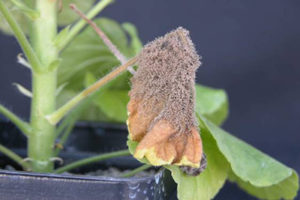A Refresher on Botrytis Management in the Greenhouse
 When the weather is moist and humid, susceptible greenhouse plants may need to be protected from Botrytis infection.
When the weather is moist and humid, susceptible greenhouse plants may need to be protected from Botrytis infection.
Botrytis cinerea is a fungus that infects many greenhouse ornamental and vegetable crops. Botrytis causes leaf spots, blighting, stem cankers and damping-off. Botrytis produces large masses of gray conidia or spores (hence the name “gray mold”) that can be carried on air currents to healthy plants where blight can become established. An Infection that starts as a small leaf spot can quickly coalesce into a large necrotic area or infect the cut stem surface of stock plants and progress downward, causing a dieback of the entire plant.
On bedding and stock plants, Botrytis typically becomes established and produces conidia on older lower leaves that are near the moist soil surface and under the plant canopy. Botrytis can also infect dead plant tissue in the pot or on the greenhouse bench or floor, which can be a source of future infections.
Plants may also be susceptible if they become wet from water dripping from overhead, dew, or condensation. Water allows Botrytis conidia to germinate and penetrate the plant.
Watering in the morning so the foliage can dry rapidly is one way to minimize Botrytis. Reducing relative humidity by spacing plants further apart and providing good air circulation can be helpful. Reduce the relative humidity for a minimum of 24 hours immediately following the harvesting of cuttings to help “dry” the wounded stems and thereby limit stem blight.
Michigan State University offers more tips on how to identify botrytis, and how to manage it through cultural practices and fungicide applications.










